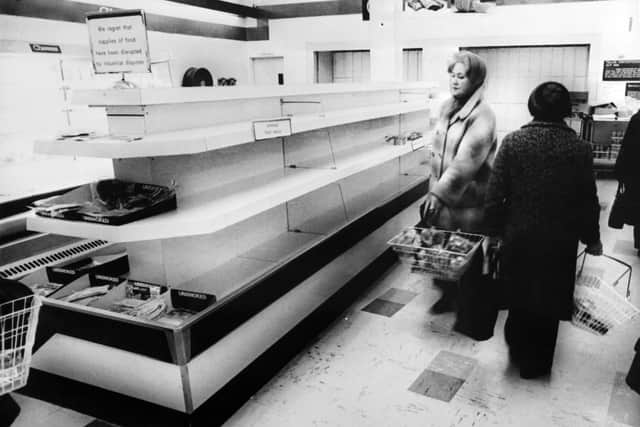Is talk of a return to 1970s industrial action credible or mere scaremongering?
Inflation is spiralling, with the nation in the grip of an energy price crisis. While some are celebrating a Royal Jubilee, many are railing against exorbitant prices and soaring bills. Even ABBA are playing sold-out UK concerts - albeit with the aid of digital technology.
Increasingly, such parallels are being seized upon by commentators, who warn Britain is in danger of reliving a decade routinely characterised as a time of hardship and decline. Much of their ire is focused on the threat of nationwide industrial unrest, and sides are being chosen. ‘We need Thatcher's iron will to defeat the union militants’, thundered one recent headline in the Daily Express.
Advertisement
Hide AdAdvertisement
Hide AdBut is there credibility to such comparisons, or is it mere scaremongering designed to turn public opinion against trade unions? And is it realistic to expect a return of widespread disruption?
As things stand, we are nowhere near the kind of entrenched disputes once witnessed. At its nadir, in the winter of 1978/79, Britain saw more than 2,000 strikes, a level of action unparalleled since the General Strike of 1926.
As Jim Callaghan's government tried to enforce pay freezes, Ford and bakery workers were followed by railway workers, and haulage and petrol tanker drivers. Come January 1979, more than a million low-paid council workers joined them.
Rubbish piling up on the streets became a defining image of the dispute, as did the strike by gravediggers in Liverpool and Greater Manchester. Only around 80 men walked out in the latter action, but the notorious images of mourners being turned away carried power.
While there are no credible indications of a repeat of such chaotic scenes in 2022, unrest is growing. Industrial disputes stand at their highest level for five years, with unions fighting on multiple fronts. In the 12 months to April, the Trade Unions Congress logged at least 300 disputes, with many linked to ongoing University and College Union strike action.


Trouble is brewing further afield. The RMT has voted overwhelmingly in favour of UK-wide action, with the union set to stage a separate ballot over ScotRail’s “derisory” 2.2 per cent pay offer. Aslef, the train drivers’ union, remains locked in talks with the newly nationalised operator.
Elsewhere, civil servants in the PCS union have voted in favour of national strike action, with BT workers to be balloted on the first strike action to hit the company in 35 years. Only this week, meanwhile, GMB Scotland said industrial action “looks inevitable” unless COSLA improves its pay offer for nearly 10,000 council workers.
There is a possibility that those disputes could escalate and lead to mass walkouts, but old canny hands believe it is unlikely such a scenario will come to pass.


Advertisement
Hide AdAdvertisement
Hide AdDave Watson, a veteran figure in Scottish trade unionism, was a local government shop steward in the late 1970s, later becoming head of policy and public affairs at Unison Scotland.
He said that nowadays, unions and employers generally have a shared appetite for resolution - whether the money is available is a different matter.
“I think the difference with the late 1970s, and certainly the 1980s, is that everyone will go the extra yard now to find a solution. When you do that, there’s a higher chance of success,” he said.
“The challenge at the moment is the gap between wages and inflation. Public finances in Scotland are particularly challenging. But when there’s a stable and constructive industrial relations framework, and there is at the moment, it makes it easier.”
Others who have devoted their careers to studying the labour market and trade unionism agree, but point out that structural changes in the economy means the picture is more fragmented.
“In the sectors that have stayed unionised, there is an understanding within HR teams that negotiation is important and it sets a more productive tone,” explained Melanie Simms, professor of work and management at the University of Glasgow.
“In unions, there’s also been professionalisation in leadership roles. Some come up from shop steward level, but there’s a lot of training now.”
Compared to the 1970s, unions face an obvious disadvantage: strength in numbers. While membership levels have risen over the last five years, with a pronounced spike amongst public sector workers, the total is less than half the 13.2 million peak of 1979.
Advertisement
Hide AdAdvertisement
Hide AdThat proved short lived, of course. Numbers declined sharply in tandem with the demise of manufacturing and the privatisation of industries which had long been nationalised. Other factors have played a part, not least the efforts by successive governments in the 1980s to weaken organised labour, and the rampant growth of a casualised service sector.
Even so, do unions still have the power to cause mass disruption? Prof Simms is not convinced, but says there are sectors who retain the “power to disrupt,” such as train drivers, rail maintenance staff, and airline pilots.
She believes there may be a small number of double digit pay rises won, although they are more likely to be secured in the private sector, and will represent a “tiny” proportion of employees. Much depends on individual strategies; she pointed to the “good deals” won by the GMB for refuse workers.
Mr Watson conceded that with inflation nearly at 10 per cent, it will be difficult.
“When there’s a relatively small gap, you try to sweeten the deal with the likes of extra annual leave, but the gap’s so large, it’s hard to see what’ll happen.”
It may be that deals will be done, and the growing sense of unease will be nipped in the bud. Either way, Prof Simms urged people to carefully consider the drivers behind the current situation.
“I’d be cautious about making comparisons with the 1970s,” she advised. “I think people are fearful, and they have reasons to be fearful, but it comes mainly from the energy companies - not trade unions.”
Comments
Want to join the conversation? Please or to comment on this article.
